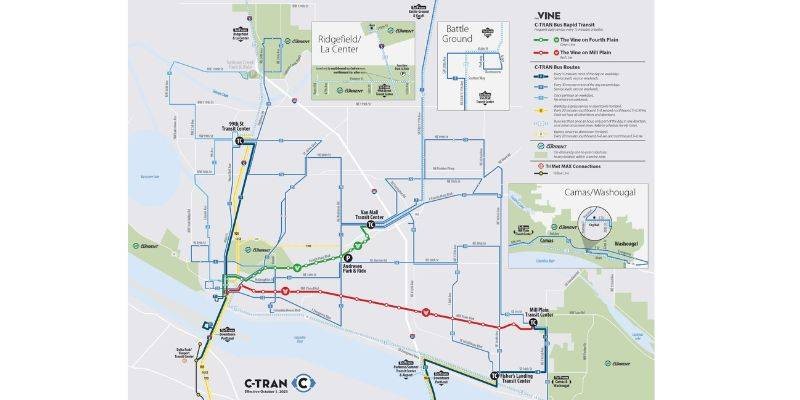News
Sustainable Commuting in Clark County
Businesses have both direct and indirect impacts on the environment. Much of a business's environmental impact can be measured in terms of resulting greenhouse gas, or GHG, emissions. In this article we are going to cover the topic of employee commuting, which is considered an indirect type of GHG emission. Read on to learn more about alternatives to drive-alone commutes, the benefits they provide, and helpful information to assist you in promoting sustainable commuting at your workplace.
If you are interested in learning more about calculating GHG emissions for your business and tools that can help with the accounting process, check out our recent article on emissions accounting.
Public transportation system in Clark County
In Clark County, our primary public transportation service provider is C-TRAN, a certified Clark County Green Business. C-TRAN has a few different types of service options available, including several bus routes that service a large portion of the county and a rideshare program. If you aren't already familiar with what C-TRAN services and routes are near your business, we encourage you to visit them online to use their trip planner or download the Transit app to find out. The Transit app also offers a feature that allows you to request a ride through Current, the C-TRAN rideshare service that is available in five service areas in the county which are marked on the map below.
For groups of 5 or more employees, vanpool is another commute option available to those looking to carpool.
Benefits of riding transit
There are many benefits of public transportation, not only to individuals, but also to communities and the environment. According to the American Public Transportation Association, "every $1 invested in public transportation generates $5 in economic returns." In terms of environmental impact, the University of California estimates that taking public transportation instead of driving alone can reduce CO2 emissions by 45%.
If those reasons aren't enough, here are a few more of the personal benefits that come with riding transit:
- The ability to sit back and enjoy the ride: Transit riders get to reclaim their commute time. As a passenger, you can spend your commute time doing things you enjoy, like reading a book, learning a language or knitting. You can also use that time to catch up on emails or take an online course you haven't been able to find the time for.
- Cost savings: This is a no-brainer. The cost of owning a vehicle, insurance, gas, and parking can really add up. APTA's latest Transit Savings Report states that individuals who ride public transit can save an average of $1,100 per month or $13,000 annually!
- Make new friends, build community and network: Driving alone is just that. When you ride public transit, you have the opportunity to share your ride with others. You might enjoy being able to make new friends or just enjoy seeing the same faces every day. You never know who you might connect with on your ride.
- Less stress: Driving can be stressful. Riding transit means you get to leave the work of driving in traffic, construction, and bad weather to the professionals.
Helpful tips for employees riding transit to work
- Plan ahead and check out nearby routes ahead of time to get somewhat familiar with the system if you've never used it before. There are a variety of online trip planners, including Google, that will suggest the best route, or routes, and schedules for your starting and ending points. You can also download Transit, C-TRAN's official mobile app for trip planning and real-time information, for step-by-step directions if you're new to riding. The app will also show the location of your bus on a map, and the estimated arrival in real time.
- Remember that you don't have to ride the bus the whole way. If you're not near a bus stop, you can park for free at one of C-TRAN's park and ride facilities, then hop on a bus from there. Many commuters also combine transportation modes, for example, biking for a segment of your trip, then taking your bike on the bus to your destination.
- For fares, C-TRAN uses Hop Fastpass, an electronic fare system that allows riders to pre-load money onto a card or digital wallet. As you step on board, simply tap the Hop card or your smartphone on the reader, and you're good to go. The Hop Fastpass system is also used on TriMet and the Portland Streetcar. Cash is also accepted.
Employer programs that C-TRAN offers to businesses in our community
C-TRAN partners with numerous businesses and nonprofit organizations who provide transit passes to their employees. C-TRAN also offers discount programs to help employers encourage their teams to use public transportation. Discounted passes are offered to 501(c)(3) organizations who purchase more than 250 limited-use "day" passes. C-TRAN also offers a discounted annual pass for any employer, which is a 12-month pass for the price of 11 months. Many other employers in Clark County choose to simply purchase transit passes directly from C-TRAN at cost, then provide them to their employees for free or, in some cases, set up their own programs where employees might contribute to the cost or receive them at a discount. It can also help both the employee and business avoid the hassle and cost of parking.
For a different mode, C-TRAN also offers a Vanpool program for at least five commuters who might be heading to the same destination. Vanpool users pay a low monthly fare based on the mileage and other factors, and C-TRAN provides the vehicle, insurance, fuel and maintenance. The Vanpool group decides its own schedule, and pick-up and drop-off location.
If you are interested in learning more about employer programs with C-TRAN, contact them at 360-695-0123.
Other alternatives to drive-alone commutes: Walking, wheeling, and cycling
It's no secret that walking and cycling to work have the added benefit of increased physical activity. These modes also boast the lowest transportation costs and lowest carbon footprints. Although these options may not be accessible for all of your employees based on distance. Walking is usually best for commutes of about 2 miles or less, and cycling 5 miles or less. Resources are available to help make using these modes simpler and less intimidating. In Clark County, we have GetThereSWWashington.Org, a website that helps connect those looking for a greener commute with the information, tools, support, and motivation needed to be successful.
Emergency Ride Home policy
If you do not already have an Emergency Ride Home policy but would like to start promoting alternative commute methods at your workplace, look in to creating one! Emergency Ride Home policies act as a back-up plan to quickly get an employee home in the case of illness, family emergency, etc. They often provide for an employer-covered taxi or rideshare service ride home if an employee experiences one of these emergencies on a day they used an alternative commute method.
The law may require you to promote alternatives to drive-alone commutes at your business
While there are many reasons for businesses to promote alternative commute methods, including less demand for parking, it may also be required by law to have a Commute Trip Reduction Plan, or CTR. The location, hours, and staffing of your business determine whether the CTR requirement applies. According to the Washington State Department of Transportation, "The State Commute Trip Reduction Law affects worksites with 100 or more full-time employees who begin their shift between 6 and 9 am on weekdays in the nine most populous counties in the state…"If applicable, the law requires your business to regularly distribute information to employees about alternatives to driving to work alone to help reduce the number of single occupancy vehicle trips. There are many other elements of the CTR law, including local ordinances. To learn more, view local CTR ordinances and find helpful commuting resources, visit the Get There SW Washington website.
Regardless of whether or not your business is required by law to have a CTR plan, its always encouraged to do so.If you have questions about CTR for businesses, please call 360-487-7939 or e-mail the CTR Staff.
Resources and links:





